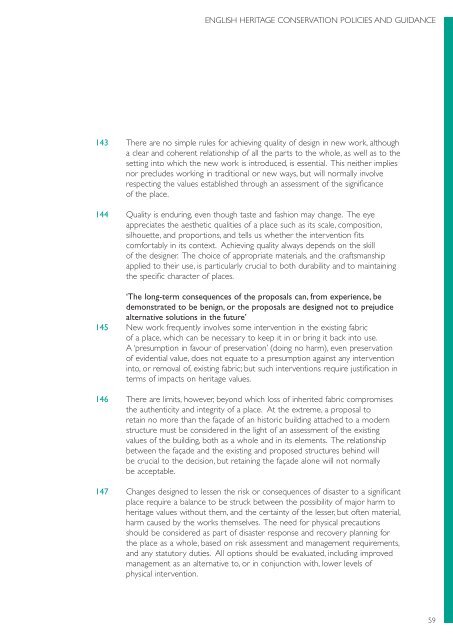Conservation Principles, Policies and Guidance - English Heritage
Conservation Principles, Policies and Guidance - English Heritage
Conservation Principles, Policies and Guidance - English Heritage
Create successful ePaper yourself
Turn your PDF publications into a flip-book with our unique Google optimized e-Paper software.
ENGLISH HERITAGE CONSERVATION POLICIES AND GUIDANCE<br />
143 There are no simple rules for achieving quality of design in new work, although<br />
a clear <strong>and</strong> coherent relationship of all the parts to the whole, as well as to the<br />
setting into which the new work is introduced, is essential. This neither implies<br />
nor precludes working in traditional or new ways, but will normally involve<br />
respecting the values established through an assessment of the significance<br />
of the place.<br />
144 Quality is enduring, even though taste <strong>and</strong> fashion may change. The eye<br />
appreciates the aesthetic qualities of a place such as its scale, composition,<br />
silhouette, <strong>and</strong> proportions, <strong>and</strong> tells us whether the intervention fits<br />
comfortably in its context. Achieving quality always depends on the skill<br />
of the designer. The choice of appropriate materials, <strong>and</strong> the craftsmanship<br />
applied to their use, is particularly crucial to both durability <strong>and</strong> to maintaining<br />
the specific character of places.<br />
‘The long-term consequences of the proposals can, from experience, be<br />
demonstrated to be benign, or the proposals are designed not to prejudice<br />
alternative solutions in the future’<br />
145 New work frequently involves some intervention in the existing fabric<br />
of a place, which can be necessary to keep it in or bring it back into use.<br />
A ‘presumption in favour of preservation’ (doing no harm), even preservation<br />
of evidential value, does not equate to a presumption against any intervention<br />
into, or removal of, existing fabric; but such interventions require justification in<br />
terms of impacts on heritage values.<br />
146 There are limits, however, beyond which loss of inherited fabric compromises<br />
the authenticity <strong>and</strong> integrity of a place. At the extreme, a proposal to<br />
retain no more than the façade of an historic building attached to a modern<br />
structure must be considered in the light of an assessment of the existing<br />
values of the building, both as a whole <strong>and</strong> in its elements. The relationship<br />
between the façade <strong>and</strong> the existing <strong>and</strong> proposed structures behind will<br />
be crucial to the decision, but retaining the façade alone will not normally<br />
be acceptable.<br />
147 Changes designed to lessen the risk or consequences of disaster to a significant<br />
place require a balance to be struck between the possibility of major harm to<br />
heritage values without them, <strong>and</strong> the certainty of the lesser, but often material,<br />
harm caused by the works themselves. The need for physical precautions<br />
should be considered as part of disaster response <strong>and</strong> recovery planning for<br />
the place as a whole, based on risk assessment <strong>and</strong> management requirements,<br />
<strong>and</strong> any statutory duties. All options should be evaluated, including improved<br />
management as an alternative to, or in conjunction with, lower levels of<br />
physical intervention.<br />
59

















